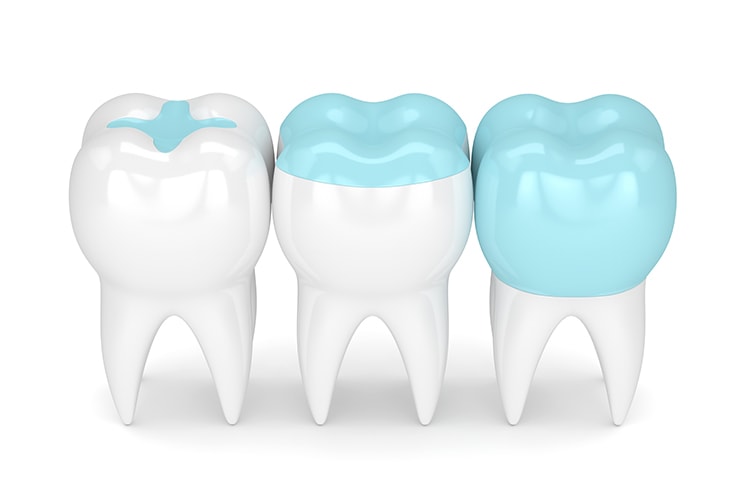
At 32ology, cosmetic dentist Argina Kudaverdian, DDS offers a wide range of services that can help patients achieve their dream smile. With a vast array of treatments available, it can seem overwhelming trying to decide which option best suits your individual dental needs and goals. For example, fillings, onlays, and crowns are all restorative dental procedures used to repair damaged teeth, but they differ in their scope and the extent of tooth structure they cover.
Below, Dr. Kudaverdian breaks down the differences between these three procedures.
Dental Filling:
Dental fillings are typically used to repair small-sized cavities caused by tooth decay. They involve removing the decayed portion of the tooth and filling the space with a dental material such as composite resin. Historically, amalgam was used which are commonly called “silver fillings.” At 32ology Dental Studio, we do not place any amalgam fillings.
Advantages:
- Requires minimal removal of healthy tooth structure.
- Can be finished in one appointment.
Disadvantages:
- Composite resin is a weak material, so fillings tend to break over time. This can lead to decay underneath and sensitivity. Replacing failed fillings can lead to further drilling away of tooth structure.
- Not meant for biting surfaces because they break easily.
- Technique sensitive, so the shape and marginal integrity of the restoration is not ideal. Bubbles or gaps between the teeth may occur.
Onlay:
An onlay is a type of indirect restoration that covers a larger portion of the tooth than a filling but is more conservative than a crown. It is used when a tooth has significant decay or damage that cannot be adequately repaired with a filling but still has enough healthy tooth structure to support the restoration. They are custom made in a dental laboratory based on impressions of the prepared tooth.
Advantages:
- Made of very strong porcelain material that lasts much longer than fillings, often 10 to 30 years.
- Lengthens the lifeline of the tooth as the tooth is protected for many years and typically undergoes fewer procedures if maintained well.
- Covers the biting surface of the tooth as well as one or more cusps (points) but does not extend to the gumline.
- Blends in with the tooth as color is customized to match adjacent teeth and is highly polished.
- Shape and margin integrity is ideal as it fits perfectly within the tooth because it is custom hand made outside of the mouth to fit perfectly.
Disadvantages:
- Procedure takes two appointments. During the first appointment we remove the decay, shape the tooth, and take an impression of the teeth to send to the lab. Second appointment is for the seating after it is approved by the dentist and patient. The patient will have a temporary onlay in place, usually for two weeks, while waiting for the permanent one.
Dental Crown (also known as a dental cap):
A dental crown covers the entire visible portion of a tooth above the gumline. It is used when a tooth is extensively decayed, weakened, cracked, or otherwise compromised and cannot be effectively restored with a filling or onlay. Crowns are typically made from materials such as porcelain, zirconia (white metal), porcelain-fused-to-metal, or gold. They are custom designed to match the shape, size, and color of the natural tooth. Unlike fillings and onlays, crowns require significant reduction of the tooth’s structure to accommodate the restoration.
Advantages:
- Can protect the tooth from completely fracturing.
- Can be made to match natural teeth.
- Usually lasts 10 to 30 years, similar to onlays, if maintained well.
Disadvantages:
- Requires a significant amount of drilling away of the healthy tooth structure to make space for the crown.
- Puts the tooth at risk for nerve damage and possibly needing a root canal in the future. This can shorten the lifespan of the tooth.
In summary, while fillings, onlays, and crowns are all used to repair damaged teeth; the choice of treatment depends on the extent of the damage and the amount of healthy tooth structure remaining. To learn more about restorative dental treatments or to schedule a consultation with Dr. Kudaverdian, contact our office today.